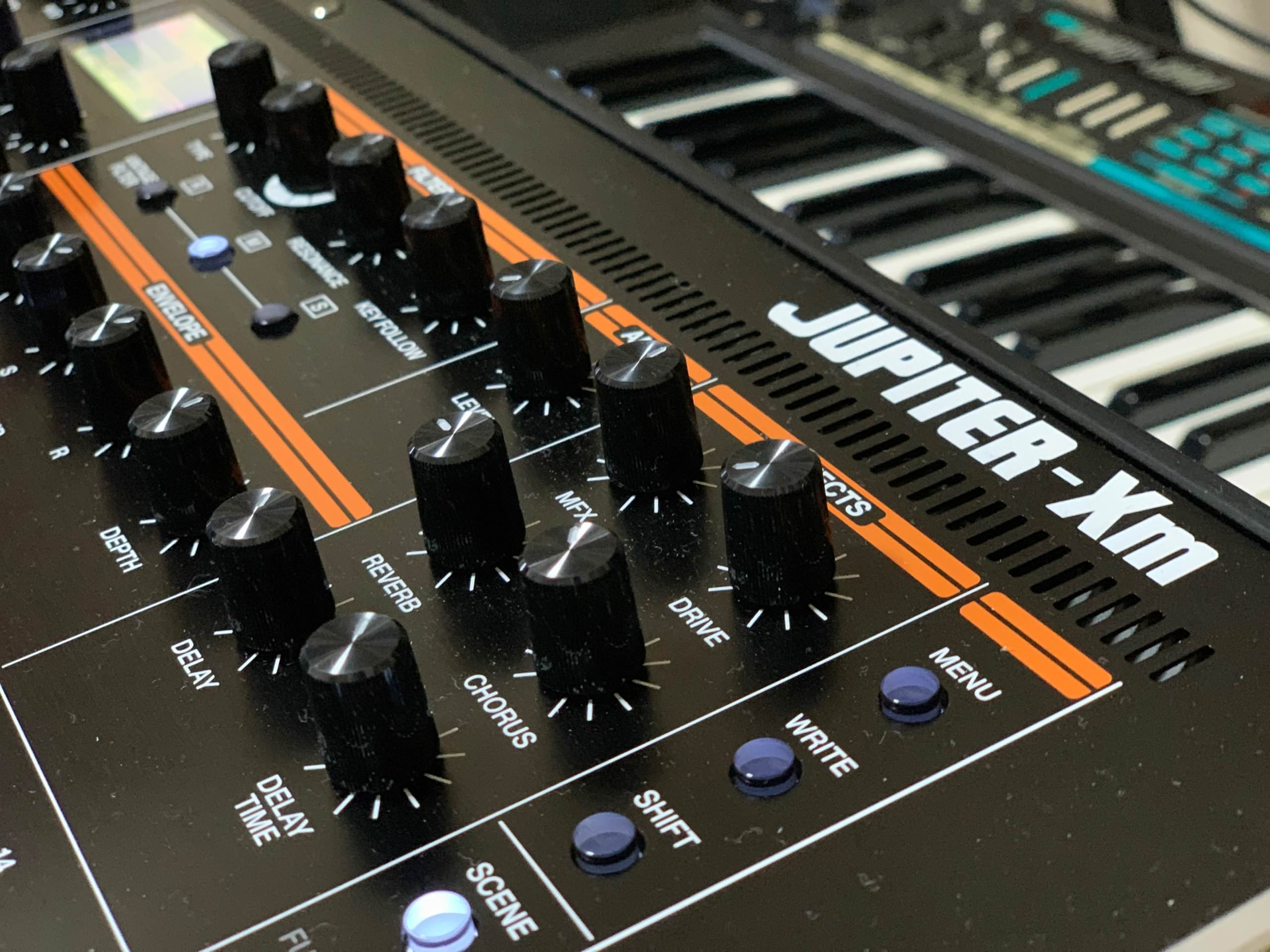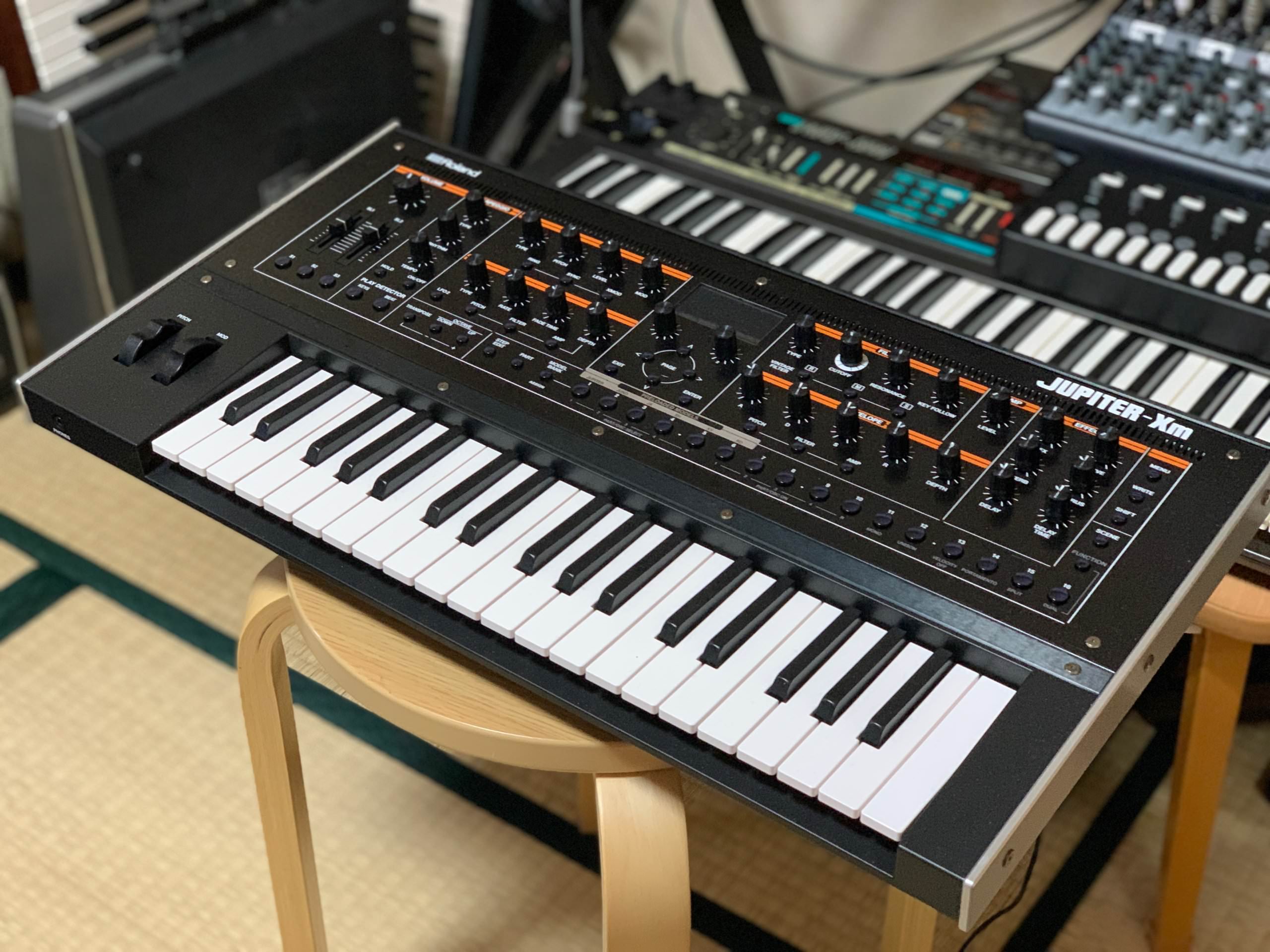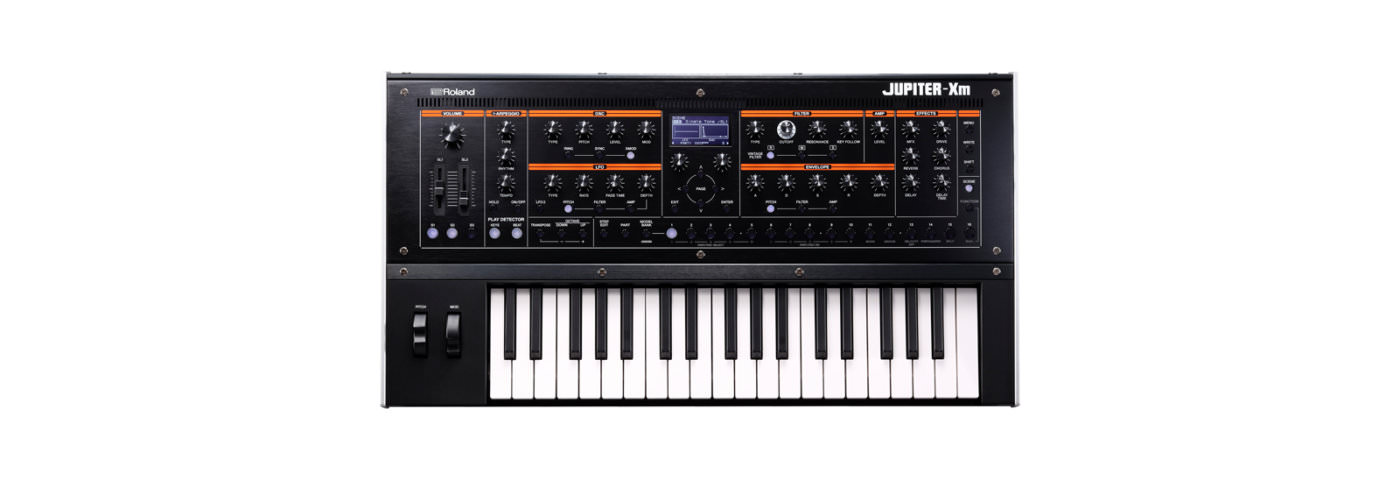Any return of a Jupiter-badged synth from Roland is likely to pique interest. But how about a ‘best of’ Roland synths crammed into one digital synth? Adam Douglas takes a better look at the Jupiter-Xm.
Imagine your Roland dream machine. If you could combine five or six of your favourite Roland synths and modules, what would go into the mix? If you said Jupiter-8, Juno-106, JX-8P, SH-101, and XV-5080, then keep reading. You’re probably going to want a selection of carefully modelled pianos as well. How about some from the RD series? And while we’re dreaming, let’s throw in a bunch of drum one-shots sampled from classic kits like the TR-808, TR-909, and CR-78. As you’ve probably already cottoned on, we are indeed talking about reality and not fantasy, and the subject of our little game of make-believe is the Roland Jupiter-Xm.

A pet project of Roland CEO Jun-ichi Miki, the Jupiter-Xm was designed to fulfil a certain niche in the synth market. “While I often imagine a home studio filled with my favourite synths and other keyboards all connected and ready to play through professional outboard effects,” Miki said on the Roland website, “the truth is I don’t have the time or patience to maintain this, nor do I have the space.” To this end, he designed the Jupiter-Xm to be an all-in-one synthesizer studio, complete with effects, audio interface, and built-in speakers.
Portability was also a major concern. The flagship Jupiter-X has 61 semi-weighted keys and is meant to sit at the heart of a studio. As per Miki’s vision of an all-in-one studio synth, the more diminutive Jupiter-Xm is much more portable, having only three octaves. While this could be seen as a drawback by some, the smaller footprint means it can be used almost anywhere, or in Miki’s words, “almost like a module version” of the Jupiter-X.
What’s In A Name?
So let’s get this out of the way first. The Jupiter-Xm is a digital synthesizer. With a few recent exceptions (the SE-02 made in partnership with Studio Electronics and the System-500 designed with Malekko), Roland doesn’t really do analogue anymore. They don’t chase ghosts, as they say. But they do like using the Jupiter name, a name associated with one of the most famous analogue synths of all time, the Jupiter-8.
Miki addressed those pining for an all-analogue Jupiter-8 remake directly. “Roland has given the Jupiter name to the premiere professional performance synthesizer from every era; if we count the JP-8000 and JP-8080, there have been seven previous Jupiter models. With this in mind, it actually seemed very natural for us to call these new instruments Jupiter.” So there you go. It’s the current flagship model so it gets the name Jupiter.
At the heart of the new Jupiter-Xm (and big brother X too) is a new synthesis standard that Roland is calling ZEN-Core. A mix of analogue modelling and PCM sounds, it’s been implemented across much of Roland’s current lineup, including the new Fantom series and MC-101 and MC-707 grooveboxes. Almost a synthesis ecosystem, the idea is that you can design a sound on one ZEN-Core-equipped instrument and port it over to another. Craft a patch on your MC-101 on the go and then stick it in your Jupiter-Xm when you get home and add it to a song. More on this functionality later.
Probably the part that will have most people excited is the analogue modelling side of ZEN-Core. The Jupiter-Xm includes Model Banks, or individual emulations, of classic Roland kit. As mentioned before, this includes the Jupiter-8, Juno-106, and SH-101, and the underrated JX-8P (perhaps the first time an official emulation of this ‘80s poly has appeared anywhere). Analogue modelling is done with a new technology called ABM, or Analogue Behaviour Modeling. While not as intensely detailed as Analogue Circuit Behaviour, the format at the heart of Roland’s boutique line, ABM still sounds full and lush and is more forgiving on the system CPU, allowing for quite a bit more polyphony (256 notes!) than ACB. It also allows for layering and multitimbrality.

The other synthesis component of ZEN-Core is PCM playback. We’ve been anticipating the return of PCM synthesis for a few years now, and it’s nice to see Roland taking advantage of its not insignificant PCM back catalogue. The Jupiter-XM includes hundreds of sounds culled from the popular XV-5080 module (which included sounds from the JV-1080 and other modules), plus a whole host of acoustic samples and drum sounds.
Diving In
The Jupiter-Xm has a 37-key, three-octave, velocity-sensitive keyboard. It uses mini-keys, not full-size keys, which is a little surprising at this price point (a not insignificant £1,319). To the left of the keyboard are pitch and modulation wheels. The chassis is made of metal and plastic, with sturdy endless encoder knobs and responsive buttons. Decked out in black and orange, it recalls its namesake ancestor the Jupiter-8 but isn’t a slavish copy. The speaker grille that runs along the top is a nice touch, recalling the Jupiter-8’s heat vents.
The Xm’s synthesis architecture is hierarchical so let’s start at the top. When you first turn on the unit, you’ll be in Scene mode. A Scene is a combination of a number of elements, including up to five Parts (synth models or rhythms), multi-effects for each Part, effects such as drive, reverb, chorus, and delay for each Scene, plus any sequences or arpeggios. With the ability to layer up to five Parts, plus all of the available, rather beautiful effects on hand, Scenes can sound full and lush—almost too full at times, but “too full” depends entirely on the track you’re currently working on. We built a string patch combining a number of pad sounds with various attack times, plus a pluck from the SH-101, all soaked in reverb and chorus, and it was instant breakdown heaven.
Next let’s look at the Parts. As stated before, each Scene can have up to five Parts: four Models and one with drum sounds. You don’t have to work with five Parts at the same time—you can limit yourself to just one if you like. (Parts can also be played in isolation using different MIDI channels.) The classic synth emulations sound great, with plenty of detail and analogue-style buzz. The SH-101 does not disappoint in the low end, and the JX-8P is brassy and smooth. The lab coats at Roland have even included a physical temperature sensor inside the hardware to emulate temperature-related oscillator drift (this can be modified or turned off as well). The filters are beautiful as well, and even include emulations of the Moog ladder filter and Sequential Circuits Curtis filter.
Continuing down the hierarchy, we next have Tones, or patches to the rest of us. Each Model has its own list of Tones, which can be modified with the onboard knobs. Each Part is reflected in the panel controls differently, as each emulated system has unique functionality, so you’ll need to keep this in mind when editing the sounds. It may help to keep a copy of the manual open until you become familiar with all of the possible control variations. Lastly, each oscillator has its own Partials. This word should be familiar to anyone who has programmed a D-50 or D-05. For emulated instruments this refers to each oscillator in the Part. Some may have many, such as the SH-101, which has sawtooth, square, sub, and noise oscillators, or it can refer to digital partials or PCM sounds that can be layered. There are also Zones for splitting and layering the keyboard.
As befitting a synthesizer that does so much, the Jupiter-Xm is a little more complex to use than the classic subtractive synthesizers that it’s emulating. While the main panel is laid out in classic subtractive fashion, with knobs for oscillator control in the upper left and LFO below, and filter and envelope controls to the right, at its heart this is a complex digital synth, with all of the menu diving you might expect from a digital synth, and so you’ll doing most of your work with the unfortunately smallish graphic LCD display in the centre and the array of buttons laid out below it.
Getting around the architecture as revealed in the display is done with a combination of buttons and rotary encoders. It’s frankly a little complicated and not entirely intuitive, particularly if you’re used to basic subtractive synthesis. The nomenclature (Scenes, Parts, Models, etc.) can be hard to hold in your mind while executing button-press combos and remembering wherein the menu you are. The Jupiter-Xm is capable of quite a lot but getting to the part you want to change can sometimes be a frustrating exercise in trial and error. The manual is not always as helpful as it could be either. This machine is just crying out for an editor.

ZEN-Core And Connectivity
Roland has made much of ZEN-Core’s ability to share sounds across instruments, and although we were able to get ZEN-Core updated on the Xm (it needs to be running firmware 1.10 for this functionality) the MC-101 and MC-707 have yet to be updated so we couldn’t try sharing in this way. We were able to download the free ZEN-Core sound packs available on Roland’s website. They cover a number of dance music genres and hopefully, there will be more available soon. The possibility of sharing sounds across machines is certainly intriguing but we’ll have to wait and see how it is ultimately implemented.
One bugbear in terms of ZEN-Core is that firmware and sound packs have to be installed via USB memory stick—despite the fact that it can send audio and MIDI data via USB 2.0. It seems unnecessarily clunky for 2020, especially when much less expensive machines like the Korg Minilogue and Arturia Microfreak can do it.
Much like the Boutique line of Roland instruments, the Jupiter-Xm can send and receive audio and MIDI via USB, and this works without a hitch. You’ll need to download the appropriate audio drivers to split the audio into separate channels in your DAW so you’re not stuck always working with the stereo mix (but you can, of course, do this as well). The Xm also has traditional DIN MIDI in and out as well as stereo balanced and unbalanced audio outputs, plus a microphone in for the vocoder, as well as an auxiliary in for playing along to external audio. External audio can not be routed through the filters though.
And More
Yes, there’s more. It’s clear Roland wanted the Jupiter-Xm to be all things for all people. We can’t remember the last time a synth had so many extra bells and whistles.
Perhaps most surprising is the arpeggiator, which includes AI co-developed by Meiji University in Tokyo. More than just a simple arpeggiator, this one changes patterns as you play and even includes drum rhythms. It’s pretty fun and a great way to spark song ideas. We’re not in love with the rhythm accompaniment but the volume can be easily turned down. There’s also a basic pattern sequencer which is a nice if superfluous addition, given the synth’s complexity.
What else? The synth has speakers, which are actually not bad. It has Bluetooth audio, so you can pair your mobile device with it and play Spotify through it. Not sure you’d want to do that, but you can if the mood strikes you. You can also set up wireless MIDI and control music apps with it. Again, nice to have but not essential.
We’re a big fan of the macro-control performance sliders, though, which are useful for global effect control. Given that you’re essentially controlling five instruments simultaneously, it’s a convenient way to assign, say, a global filter and cutoff. There’s also a vocoder for when the electro mood strikes you.
Final Verdict
The Jupiter-Xm is a nice bit of kit, we must admit. It sounds gorgeous, for a start. It’s also sturdy and can no doubt stand the rigours of the road, which is where this will likely shine the most. With a renewed interest in hardware, more and more musicians are opting to take their vintage equipment back out on the road. There are a lot of minuses to this, and having a single machine that can faithfully replicate so many classics in one box is a boon for the touring synthesist.
Another potential buyer is the studio musician looking to expand outside of the box for the first time. For someone with limited desk space but unlimited imagination, the Jupiter-Xm can tick a lot of boxes, its ability to integrate into a DAW without the need of an audio interface being a big plus, and not to mention its multitimbrality.
We like it, we really do, but at £1,319 it’s fairly expensive, particularly given the short keyboard and mini-keys. We would have liked to see fewer extras (Bluetooth audio, for example) and more keys. That being said, we’re looking forward to see how the whole ZEN-Core ecosystem comes together, and we’re excited to see what classic synth Model expansions will be added.
If you’re looking for a portable all-in-one solution and love the sound of classic Roland machines—and have the money to spend—the Jupiter-Xm is definitely worth a look.

